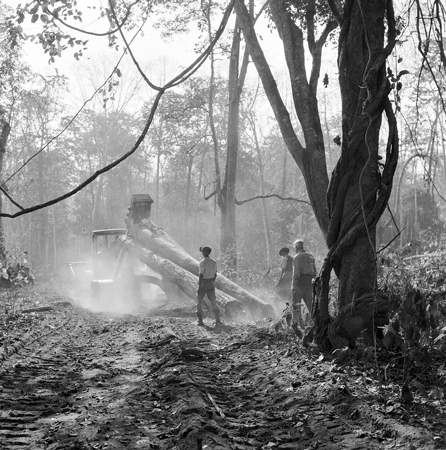The production of agrofuels: the impact on the environment

Observing the entire cycle of the agricultural process needed for agrofuels production raised some issues in relation to the environmental protection. The following are the main concerns emerged from countries where the agrofuels crop is largely and intensively practiced:
Cut of forests and indirect land use change (ILUC)In Due to shortage of arable lands, logging natural forests is considered a suitable alternative in order to obtain further areas for establishing monocropping plantations. According to the latest Global Forest Review, the world has lost 488 million hectares (Mha) of tree cover since the turn of the century, equivalent to about 12 percent of global tree cover in 2000. Tree cover loss has been rising in recent history, from 13.4 Mha of tree cover loss in 2001 to 28.3 Mha in 2023.The deforestation on large-scale, due first of all to soy and oil palm plantations, produces serious and irreparable damages in terms of capacity to absorb CO2, of soil and water quality and loss of biodiversity. The World Bank mentions that the CO2 released as a result of tree cover loss partially offsets the removal. The net effect is a removal of 7.6 billion tonnes of CO2 annually, which is about one fifth of the total global CO2 emissions from other sources.The release of CO2 for deforestation challenges, if not even nullifies, the objective to reduce the GHG emissions by using agrofuels. The difference of emissions caused by the change in the use of land is called indirect land use change (ILUC) and it is crucial for what concerns agrofuels, in particular in calculating their GHG saving. This threshold is fundamental to evaluate their efficiency and sustainability. Fargione noted that the emissions ensued from the indirect land use changes initiated by agrofuels policies around the world may be of such a magnitude that the reductions envisaged are actually being more than nullified, with global greenhouse gas emissions in fact increasing.
Monocropping technique
The technique most widely used to produce agrofuels is monocropping because it allows the production of high quantity of goods at a great rate and, for this, it meets the needs of a large-scale production. It is well known that this method is quantitatively efficient as much as qualitatively very poor. In the long term, in fact, monocropping techniques provoke soil degradation due to the modification of chemical and physical properties of soil and implies lands poorer of nutrients, with a reduced capacity to support plant life. It is to a great extent chemical and energy intensive that the amount of energy used to produce one unit of agrofuel is larger than the amount of energy that it produces.
Chemical agents
Another very critical issue is the widespread use of agrochemicals and genetically modified organisms (GMOs), the latter especially as to maize, soy and sugarcane. The use of agrochemicals and GMOs has grown in the last years to improve the levels of productivity per cultivated hectare in order to meet the growing agrofuels demand. The massive and indiscriminate use of these substances has severe impacts in terms of environmental contamination, loss of biodiversity and human health problems. We have only to think of one of the most common methods used to irrigate the fields with pesticides or fertilizers: using planes to spray these substances on the ground. It is not difficult to figure out that this technique contributes to the spread of toxic agents all around in the air, on the lands, in the rivers, ground and spring waters. In the long-term, this kind of contamination impoverishes soil and makes it infertile, pollutes water, and reduces available resources.
Genetically modified organisms (GMOs)
Planting GMOs permits the resistance of plants to pests and to speeding up the production process, but their impact on human health and environment is not yet clearly and totally explored. However, it is sure that they interact with the biological system where they are introduced and can shock the natural equilibrium of that system with ripple effects on flora and fauna. Moreover, once introduced in a biological context they cannot be controlled: they grow up, extend and reproduce themselves, contaminating the fields around, and although all their effects are not proved, it is known that they contain toxic substances, bacteria and viruses that food has never had, which can severely affect human health. Furthermore, they contribute to the expansion of genetic homogeneity which implies the loss of thousands of species with irreparable effects on biodiversity and a greater vulnerability of organisms to pests and diseases.

